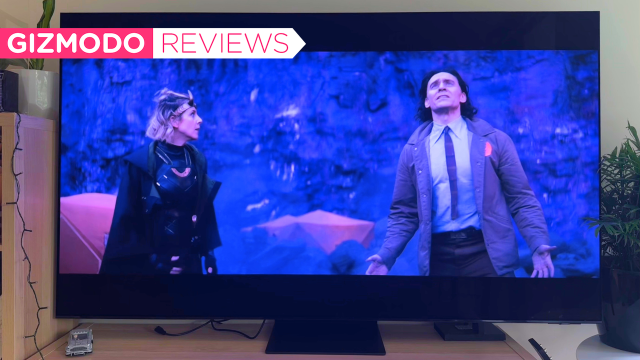If there’s one thing that’s getting harder and harder to write about the longer I handle reviews, it’s that TVs in 2023 are pretty darn good. In particular, TVs from Samsung. I’ve had the Samsung S95C Quantum Dot OLED TV set up in my loungeroom for a few months, just sitting there on its best behaviour, waiting for me to sing its praises.
And while this review is about the Samsung S95C OLED TV, it’s actually this experience that made me want to kit my entire home out in Samsung gear, including a Samsung phone. I’ll get to that soon, but let’s start at the top
Samsung S95C OLED 4K Smart TV
The Samsung S95C OLED 4K Smart TV is the best television I’ve reviewed in my two-plus years at Gizmodo Australia. The model I’ve got is the 77-inch, which at first was overwhelmingly massive. But now, I couldn’t imagine going any smaller.
The S95C OLED 4K Smart TV (model number QA77S95CAWXXY) promises rich blacks and vivid colour reproduction, powered by Quantum Dot Technology. It also boasts True Dolby Atmos and Object Tracking Sound+, which the marketing documentation from Samsung will tell you provides an immersive sound experience.
While I’ve been reviewing the 77-inch model, the TV also comes in 55- and 65-inch options. The 77-inch is $7,999, while the others will set you back $3,999 and $4,999, respectively.
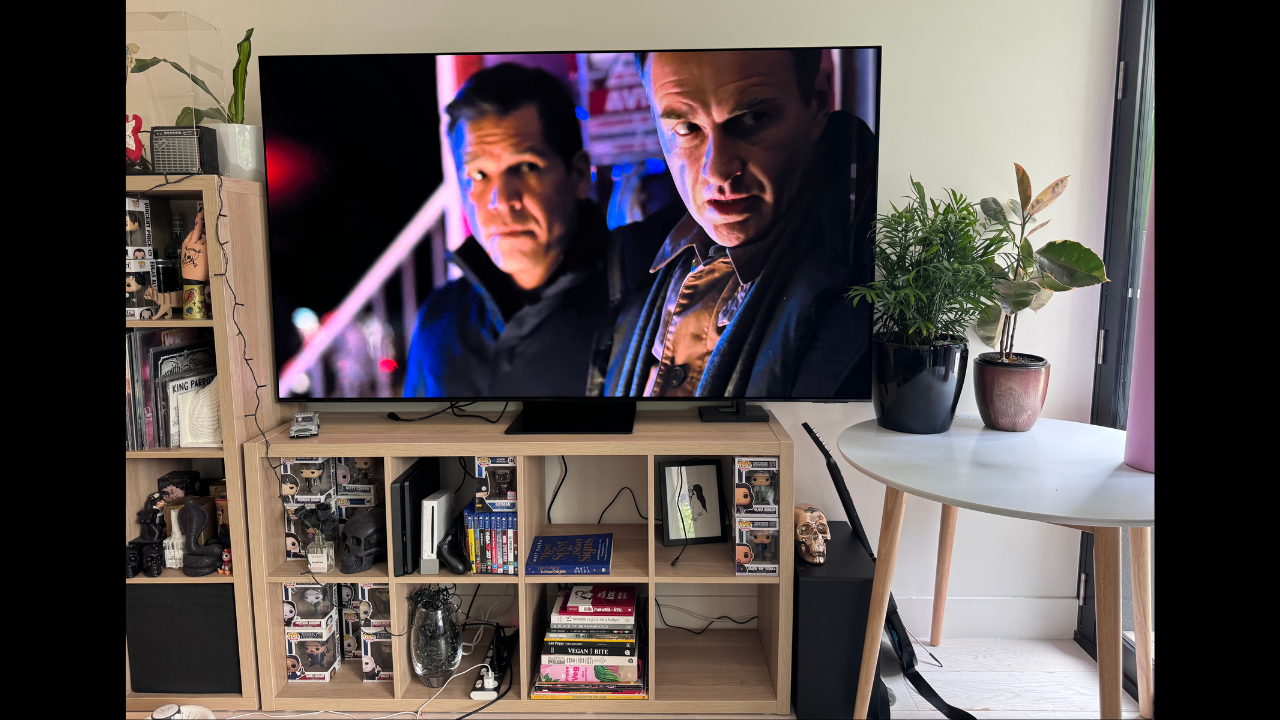
Setting up the Samsung S95C OLED 4K Smart TV was easy – because I sat back and watched the delivery folks do it for me. But, the TV comes with something called a Slim One Connect box, which essentially sits behind the TV and allows you to connect cables/cords into that box instead of the TV. Really, it’s the same process as you’re used to, but given the size of the TV, it’s much better having this centralised location to plug things into when the massive job of pulling the cabinet away from the wall materialises.
The Samsung S95C OLED TV just oozes premium, made with metal, boasting a bezel-less screen, and a super thin panel – it’s only 11.2mm. The downside to being a renter is that it has to be on a stand, and the effort I have gone to in order to prevent my cats from running behind it is ridiculous. It won’t topple over, it’s ridiculously sturdy, but that does not mean I’m not treating this thing like it’s made of eggshells.
To fixate on Quantum Dot for a second
Quantum Dot OLED (QD-OLED) is definitely different from your standard OLED flat-screen. Quantum dots are very small semiconductor nano-crystals that glow a specific colour when activated by light, and the technology results in images that are brighter, more vivid, and more accurate and natural in terms of the colours they represent. This technology has been used in television panels for a number of years now, but Samsung is improving it each time a new TV is released.
In theory, it brings the best brightness, the best contrast, the most vivid colours, and the deepest blacks possible.
In numbers, Samsung says there is over 8 million “specially engineered self-illuminating pixels” in the panel. Adding, “Each pixel consists of three subpixels (red, green and blue) to optimise brightness, colour accuracy and durability. No white subpixels in sight to compromise colour reproduction.”
But how does that look?
Unlike with other TV reviews, I’ve had the Samsung S95C OLED 4K Smart TV for long enough to sit through absolutely every type of content imaginable. Movies with fast-paced action scenes deliver accurate detail that make you convinced it isn’t CGI; those with gorgeously saturated details framing the scene in flicks like Don’t Worry Darling appear as they can be touched through the screen, and horror (re-watching The Conjuring franchise) has really put the TV through its paces with showing detail and shades of black in what would otherwise just appear as a sheet of one type of black on other, less precise televisions.

While you wouldn’t actually watch a movie like Annabelle in bright, sunny conditions, I put it on to show how even with a bit of glare (more on that later), the blacks are delivered in levels, not just as a mass blob of no light.
But there’s of course TV shows like the cartoon-esque Secret Chef that fill the screen with wall-to-wall bright, perfectly shaded colours, all while not seeing the people in front of this rainbow vomit blurred or pixeled, with their facial expressions and detail in clothing still crisp as if they were in front of a black screen.
NRL and AFL streams were only hampered by the quality being spat out by the respective streaming platforms, with the balls not blurred and the players appearing as 3D figures atop bright green grass. Watching AEW for the first time was …interesting. I never knew spit and sweat flying off someone’s face looked like that (77-inches was probably too much here, tbh).

Animations like Bob’s Burgers appeared with no blurring, bleeding, or colour distortion and I even commented one time that it looked like a hi-res drawing that was updated every millisecond before my eyes.

Playing games is where the Samsung S95C OLED 4K Smart TV shines where others come up short. The thing with gaming is that unlike watching TV, in Game Mode, you don’t benefit so much from the upscaling, rather the smarts that are enabled by the tech behind the scenes. You will also get great HDR performance, however. You can easily get a smooth 120fps (on compatible games), the best overall picture performance is around 60fps.
It’s pretty straightforward – higher refresh rates mean smoother motion and better responsiveness, but sometimes a game is best played with a predetermined refresh rate. Samsung has also done a great job of minimising input lag which results in less delay and a more seamless gameplay. Can’t do too much to fix the problems with cloud gaming in Australia, though.
But you do get a tonne of customisable features within Game Mode, such as the Game Bar which launches quick access to settings, your refresh rate, the ability to switch view type/aspect ratio.
Just a note, it was only the PS4 I played on the TV.

While all of that content came out in recent times, the TV also handles older content really well. My guilty pleasure is old episodes of Kitchen Nightmares – ones that were uploaded to YouTube in the early 2010s. This results in terrible quality content, but instead of serving it up pixelated or at the other end of the spectrum, highly AI blurred like an episode of Days of Our Lives, the S95C emits a viewing experience somewhere in the middle. The age of the eps haven’t been lost, they’re just delivered with a bit more respect than other TV models do. There is AI Upscaling, but it’s handled correctly.
But all of that said, you can fiddle with the settings yourself. By default, the TV will be set to Adaptive Picture, which adjusts the display to suit the level of light in your room. There’s also Eye Comfort Mode, which does what it says on the tin – it uses your location (local sunrise and sunset times) and removes blue light from the screen so it’s not as harsh on your eyes (or brain) when watching of a nighttime.
A worthy adversary of Aussie sun
In my loungeroom I’ve got the positive and negative that comes with floor-to-ceiling windows stretched across the entire wall (to the right of the TV). One of those panes cannot be covered by a curtain as it doubles as a door. So, with that comes bright, beaming Australian sun for half of the day. While no TV can completely eliminate the glare Aussie sun produces, the Samsung S95C OLED does a decent job.
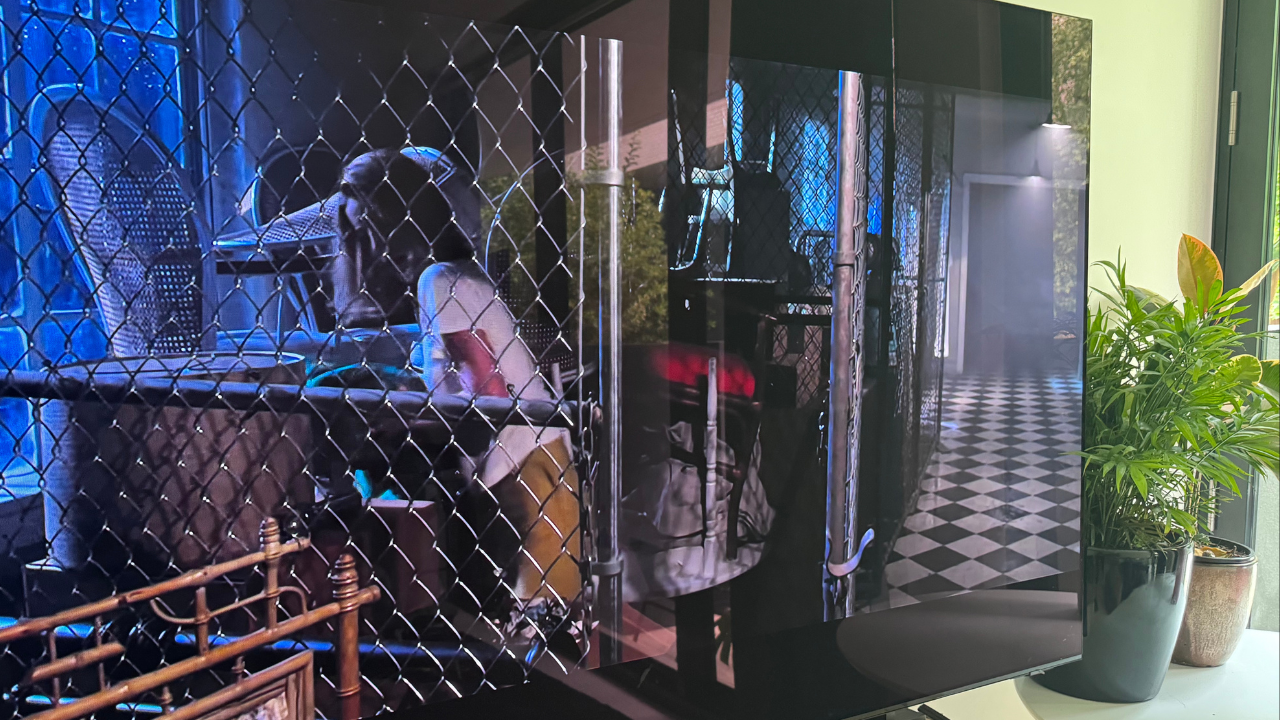
Of course, in darkness, the TV also puts on a good show, not reducing the light it’s omitting to favour the ‘vibe’ while still not burning your corneas with overwhelming brightness.
How does it sound?
Yeah, look. Not incredible, but by no means terrible. I’ve been spoiled by the addition of the HW-Q990C Q-Series Soundbar and while I’ll be separately handing down my review of the sound system, it must be said it has been a perfect pairing with the Samsung S95C OLED.
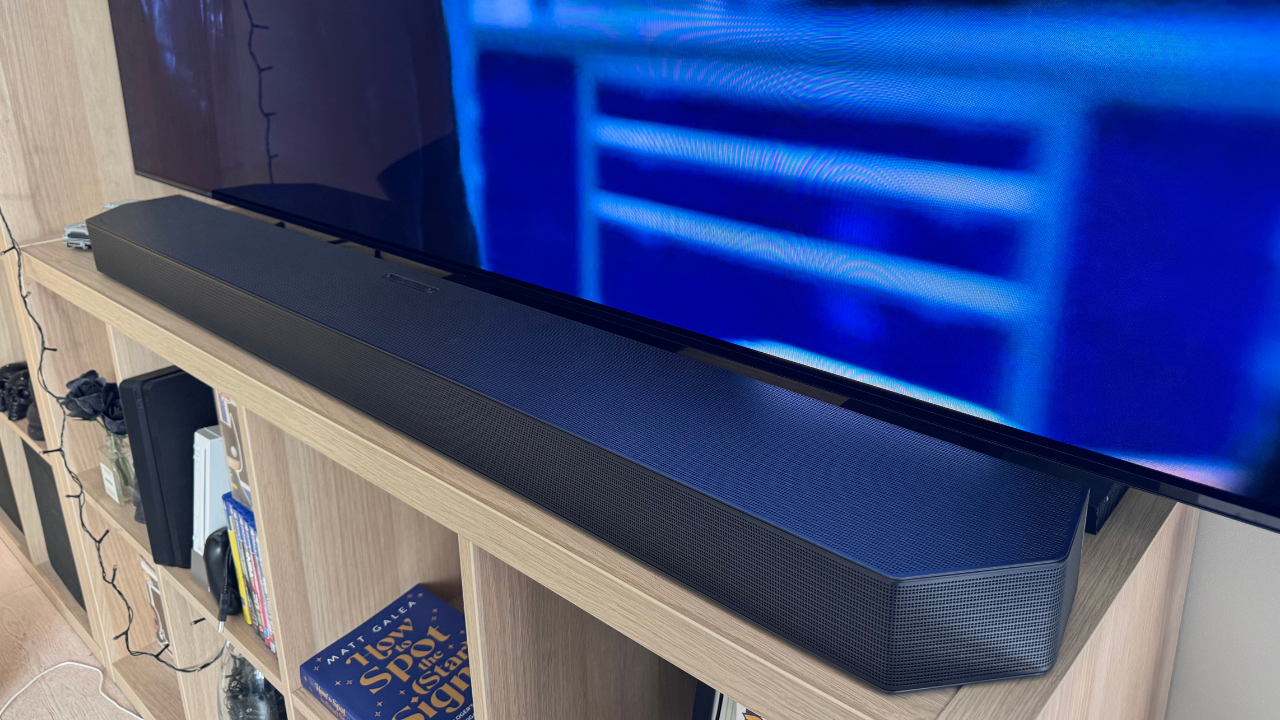
The TV does offer cinematic sound which it describes as “the Dolby Atmos experience”. The Samsung S95C OLED TV boasts inbuilt up firing speakers that send the sound up and around the room and it introduces object-tracking sound+ which uses AI and eight speakers (up- and side-firing) to create a sort of 3D sound experience.
That said, if you’re spending $7,999 on a TV, you’d be silly to not invest in a soundbar (at the very least). While you could argue a TV at that price point should have great TV sound – it does have great TV sound, it’s just great TV sound is nowhere near comparable to that of a sound system of some description.
The plus side to adding a Samsung soundbar is the fact you can have sound coming from both simultaneously to add another level of noise. It’ll also send out pings to map your space and fit the sound to your room.
A smart thing
Samsung has its proprietary SmartThings app, which allows you to connect, monitor, and control multiple smart home devices in the one spot. I’ve used it as a remote when I have been too lazy to get up to find mine, but I’ve also used it to pair other devices to the TV so it can behave somewhat like a smart hub for my home. During my time with the S95C OLED TV, I’ve reviewed with Samsung Bespoke Jet AI Stick Vacuum Cleaner, Versatile Plus AX46 air purifier, and the Z Fold 5 and Z Flip 5 folding phones and used the TV to see what the other devices were up to.
Also worth noting is that you can simply tap your Samsung phone against the side of the Samsung TV and your phone screen is immediately shared. SO COOL.
I didn’t take a photo of this and I no longer have either of the flip phones on loan, otherwise I’d show you. But, it made me truly experience how good a Samsung product works alongside another Samsung product and it’s worth considering getting a Samsung TV if you have a Samsung phone, in addition to all the reasons this article lists.
Also, shoutout to the remote. It’s solar-powered (just needs a little bit of light on the underside to work no dramas) and it fits in my small hand nicely. It also is usable for those with long/fake nails. Only downside is my cats sometimes think it’s a toy and hide it under the rug.
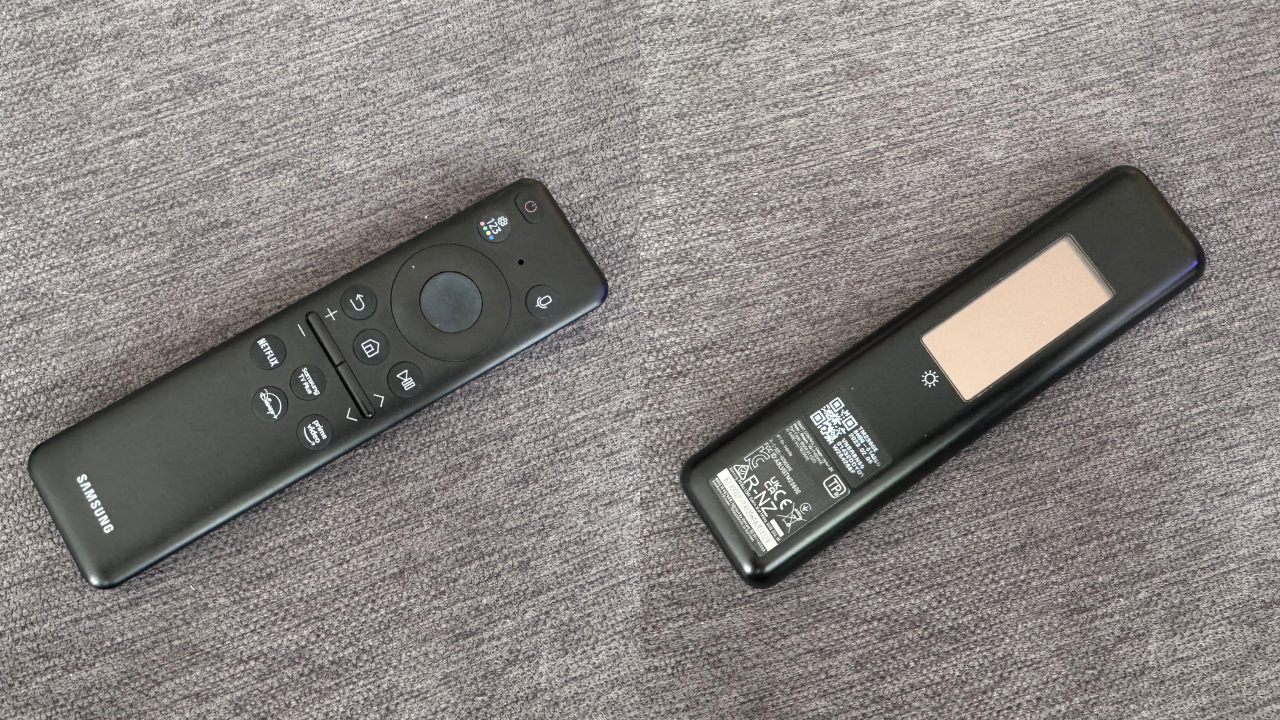
The UI is info overload
Samsung TVs have an interesting approach to the user interface. While it’s inoffensive to look it, it’s overwhelming, and favours its own Samsung TV Plus channels that I absolutely have never chosen to watch. For some reason, however, it always defaults to assuming I want to watch them.
The screen is littered with stuff I don’t ever use and I’d much prefer to have larger tiles of the apps I have installed, or even suggestions for similar shows/notifications of when a new ep of something I’m watching is up.

In my time with the Samsung S95C OLED TV I did have one issue – the TV was on but the screen was still off. I realised software updates weren’t set to automatically update and I had an update waiting there. Since doing that, which was right at the start of the TV being set up in my loungeroom, I haven’t experienced the problem again.
Final thoughts on the Samsung S95C OLED 4K Smart TV
One thing became abundantly clear within my first few days with the Samsung S95C OLED 4K Smart TV – you absolutely get what you pay for. The television is expensive, but models like this aren’t something you buy every year – it will be many years before you need to upgrade. Outside of the price, though, I have not got a single bad thing to say about the TV – it’s made for a pretty boring review, but sometimes you just have to call a spade a spade and Samsung has delivered in spades.
Image: Asha Barbaschow/Gizmodo Australia
